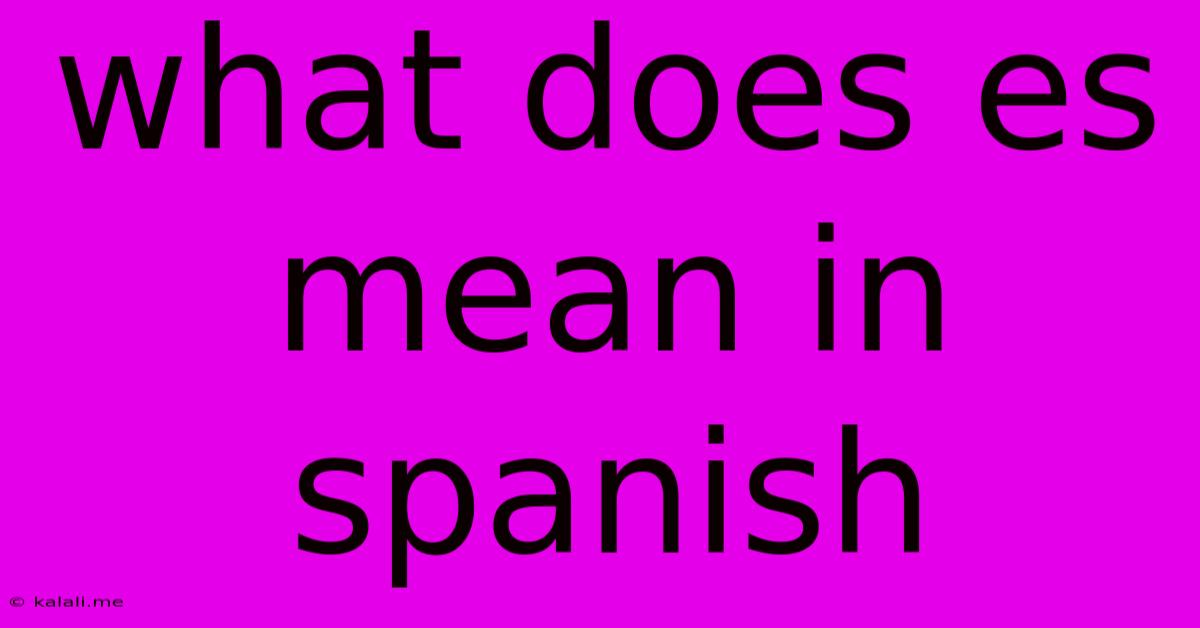What Does Es Mean In Spanish
Kalali
May 25, 2025 · 3 min read

Table of Contents
What Does "ES" Mean in Spanish? A Comprehensive Guide
Meta Description: Uncover the multifaceted meaning of "es" in Spanish. This guide explores its use as a verb conjugation, a contraction, and its role in various grammatical contexts, helping you master this common Spanish word.
The Spanish word "es" is a remarkably versatile term, holding several key meanings depending on its grammatical context. While seemingly simple, understanding its nuances is crucial for mastering the Spanish language. This article will comprehensively explore the various meanings and usages of "es" to solidify your understanding.
"Es" as the Third-Person Singular Conjugation of "Ser" and "Estar"
The most frequent use of "es" is as the third-person singular present tense conjugation of two essential Spanish verbs: ser (to be – inherent qualities) and estar (to be – temporary states/locations).
-
Ser: This verb describes inherent qualities, origins, or permanent states. For example: "Él es alto" (He is tall), "Ella es doctora" (She is a doctor), "Eso es cierto" (That is true).
-
Estar: This verb describes temporary states, locations, or feelings. For example: "Ella está cansada" (She is tired), "El libro está en la mesa" (The book is on the table), "Estoy emocionado" (I am excited).
Differentiating between "ser" and "estar" is a cornerstone of Spanish grammar. Mastering this distinction significantly improves your fluency and accuracy.
"Es" as a Contraction of "Él es" or "Ella es"
In conversational Spanish, you'll often encounter "es" as a contraction of "él es" (he is) or "ella es" (she is). The subject pronoun ("él" or "ella") is omitted for brevity and natural flow, particularly in informal speech. For instance: "Es inteligente" (He/She is intelligent). The context typically makes the subject clear.
"Es" in Other Grammatical Contexts
While less frequent, "es" can also appear in other grammatical structures:
-
Part of other verb conjugations: It can be a part of other conjugated verbs, though this is less common as a standalone meaning.
-
Informal speech: As mentioned, its use as a contraction often removes the need for the subject pronoun, making the sentence more concise.
Understanding the Context is Key
The true meaning of "es" always depends on the surrounding words and the broader context of the sentence. Paying attention to the surrounding words and phrases is crucial for correctly interpreting its meaning. Consider the entire sentence to determine whether "es" represents "ser," "estar," or a contraction.
Practice Makes Perfect
The best way to master the usage of "es" is through consistent practice. Immerse yourself in Spanish media, engage in conversations, and actively use the word in your own writing and speech. The more you encounter it in various contexts, the more naturally you'll understand and utilize its different meanings.
By understanding the context-dependent nature of "es," you'll significantly improve your comprehension and fluency in Spanish. Remember to pay attention to the surrounding words and the overall meaning of the sentence to accurately decipher this versatile word's role in any given situation.
Latest Posts
Latest Posts
-
How Heavy Was The Cross Jesus Carried
May 26, 2025
-
How To Wire A Outlet And Light Switch
May 26, 2025
-
Blender Instead Of Moving Vertex Moves Whole Object
May 26, 2025
-
Why Does Xcom 2 Recommend Not Skipping Missions
May 26, 2025
-
Fallout 4 Companion Likes And Dislikes
May 26, 2025
Related Post
Thank you for visiting our website which covers about What Does Es Mean In Spanish . We hope the information provided has been useful to you. Feel free to contact us if you have any questions or need further assistance. See you next time and don't miss to bookmark.